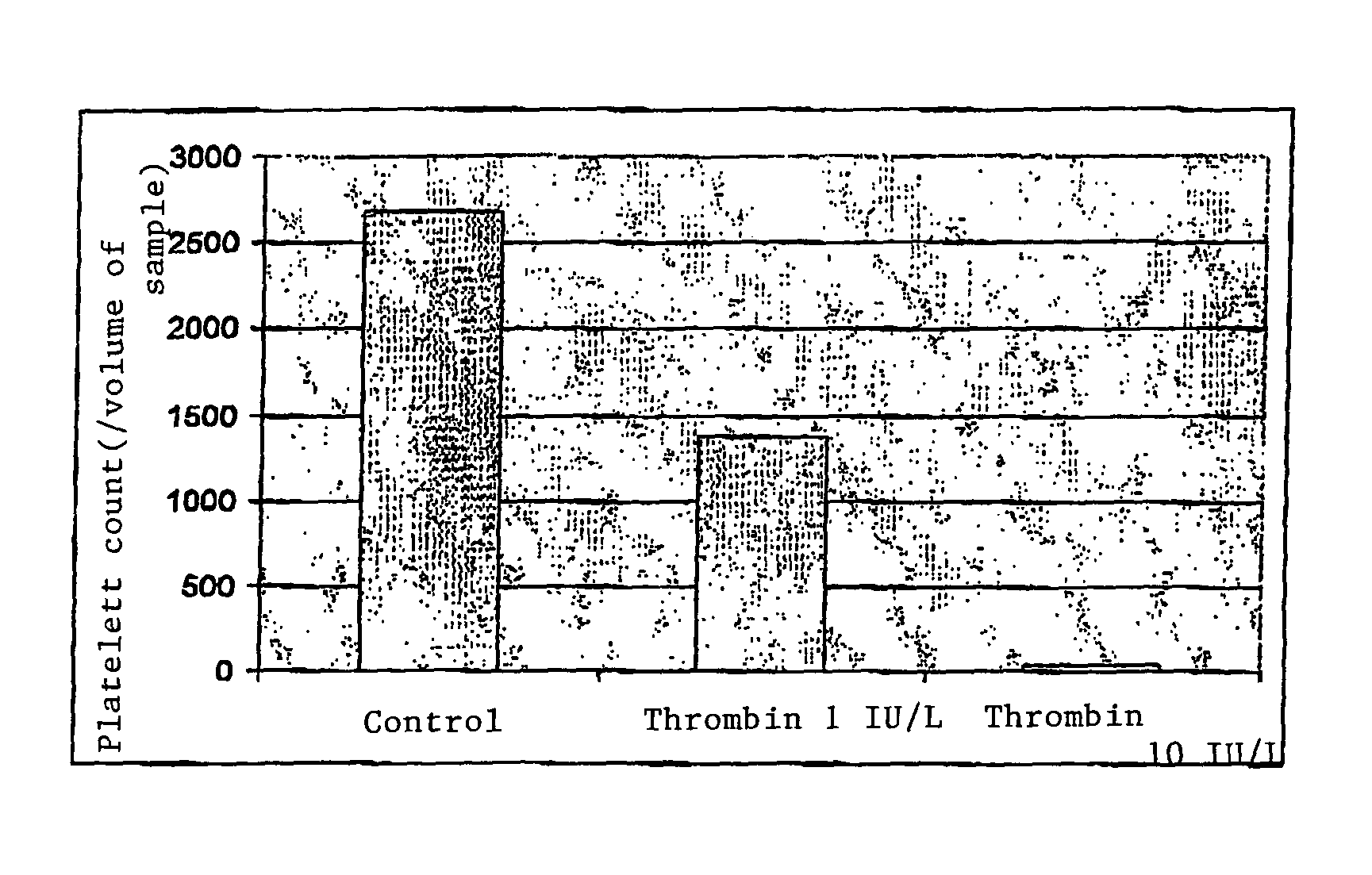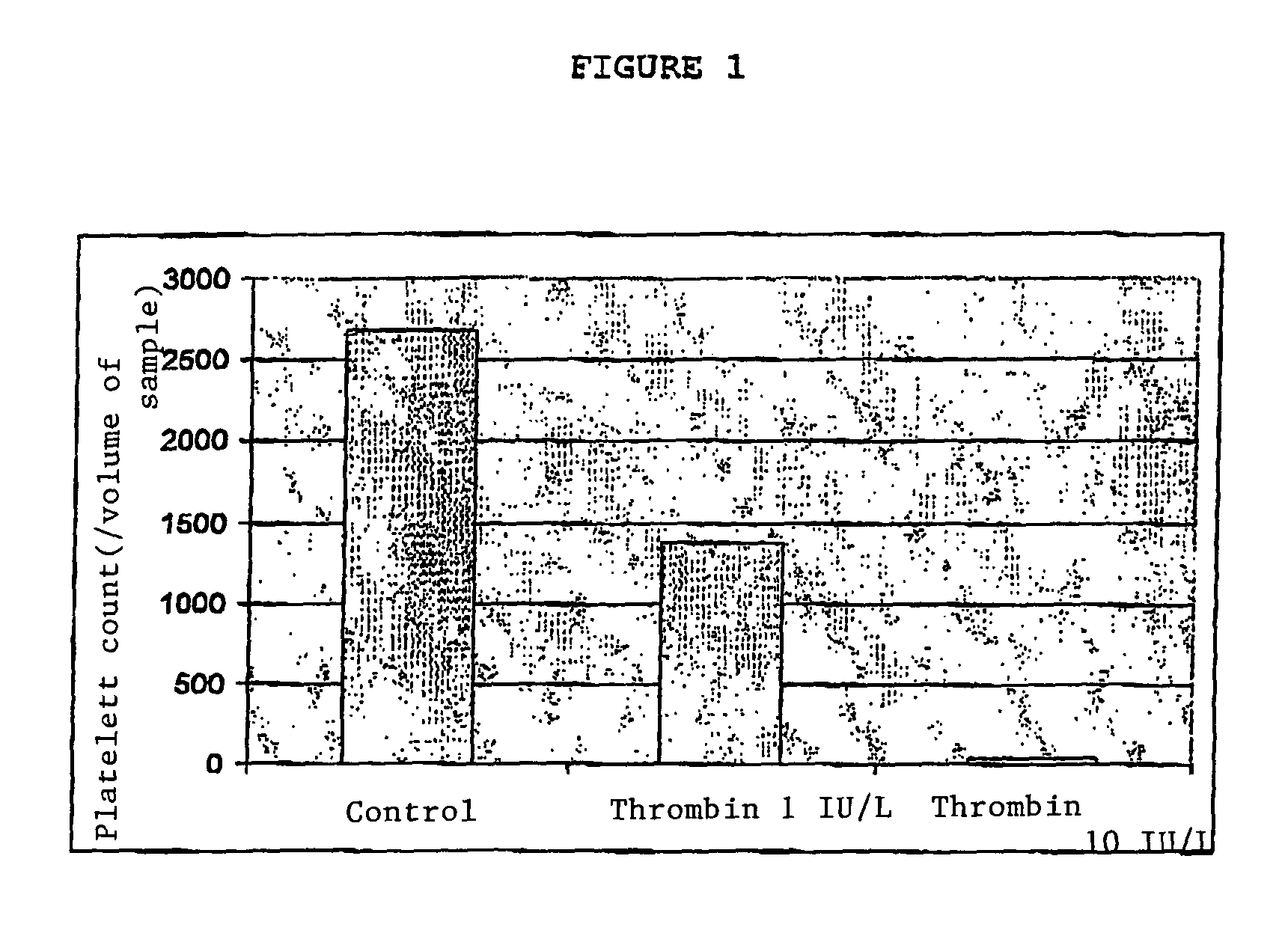Device and method for concentrating and detecting pathogenic microbes from blood products and/or their derivatives
- Summary
- Abstract
- Description
- Claims
- Application Information
AI Technical Summary
Benefits of technology
Problems solved by technology
Method used
Image
Examples
example 5a
Platelet Aggregation in the Presence of a CD9 Antibody
[0116]It is known that the CD9 antibody induces platelet activation and, consequently, their aggregation. Tests were performed with two CD9 clones, clone SN4 (Ancel, ref. 156-020, con-centration 100 μg / ml) and clone 6B1 (Hemosystem).
[0117]The selective aggregation method implemented with these CD9 antibodies comprised the following steps:[0118]400 μl of platelet concentrate was added to 50 μl of PBS buffer and 50 μl of CD9 antibody;
[0119]the tubes were agitated manually for 5 minutes at ambient temperature;
[0120]500 μl of PBS buffer was added;
[0121]filtration was performed on a filter with a porosity of 5 μm;
[0122]dilutions were performed in series of 1 / 20 and 1 / 10 and 1 / 10;
[0123]100 μl of sample was filtered on a CB04 membrane;
[0124]labeling was performed with an esterase; and
[0125]detection was performed.
[0126]The CD9 antibody (clone SN4) was used in the presence of platelets at a final concen-tration of 10 μg / ml. FIG. 2 illust...
example 5b
[0138]A dose-response curve was established to evaluate the concentration of antibody CD9 (clone 6B1) for platelet aggregation.
[0139]Method:
[0140]3 mL of platelet concentrate placed in tubes was added to different dilutions of antibody, with final concentrations ranging from 2.5 μg / mL to 40 μl / mL of antibody CD9;
[0141]the tubes were agitated manually for 15 minutes at ambient temperature;
[0142]filtration was performed on a filter with a porosity of 5 μm; and
[0143]platelet counting was performed as described above.
[0144]Attached FIG. 4 shows the counting results for aggregated platelets in the presence of increasing doses of antibody CD9 (clone 6B1).
example 6
Platelet Aggregation with the CD9 Antibody in the Presence of Bacteria
[0145]Method:
[0146]a cryobead of Staphylococcus epidermidis was introduced into a tube of tryptone soy broth and incubated at 37° C. for 18-24 hours;
[0147]400 μl of platelet concentrate placed in tubes was added to 50 μl of the Staphylococcus epidermidis suspension and 50 μl of CD9;
[0148]the tubes were agitated manually for 5 minutes at ambient temperature;
[0149]500 μl of PBS buffer was added;
[0150]filtration was performed on a filter with a porosity of 5 μm;
[0151]dilutions were performed in series: four dilutions 1 / 10;
[0152]filtration of 100 μl of the sample was performed on a CB04 membrane;
[0153]labeling was performed with an esterase; and
[0154]detection was performed.
[0155]Table 4 below illustrates platelet aggregation with CD9 in the presence of bacteria.
[0156]
TABLE 4BacteriaCD9Result% recoveryStaph.PC 10—4693epidermidis44Staph.PC 10+agitation43epidermidis48E. coliPC 1021864243E. coliPC 10CD9 + agitation166148...
PUM
| Property | Measurement | Unit |
|---|---|---|
| Length | aaaaa | aaaaa |
| Length | aaaaa | aaaaa |
| Length | aaaaa | aaaaa |
Abstract
Description
Claims
Application Information
 Login to View More
Login to View More - R&D
- Intellectual Property
- Life Sciences
- Materials
- Tech Scout
- Unparalleled Data Quality
- Higher Quality Content
- 60% Fewer Hallucinations
Browse by: Latest US Patents, China's latest patents, Technical Efficacy Thesaurus, Application Domain, Technology Topic, Popular Technical Reports.
© 2025 PatSnap. All rights reserved.Legal|Privacy policy|Modern Slavery Act Transparency Statement|Sitemap|About US| Contact US: help@patsnap.com



